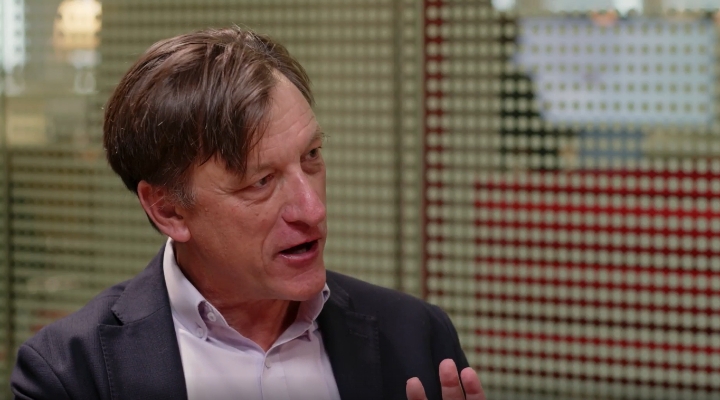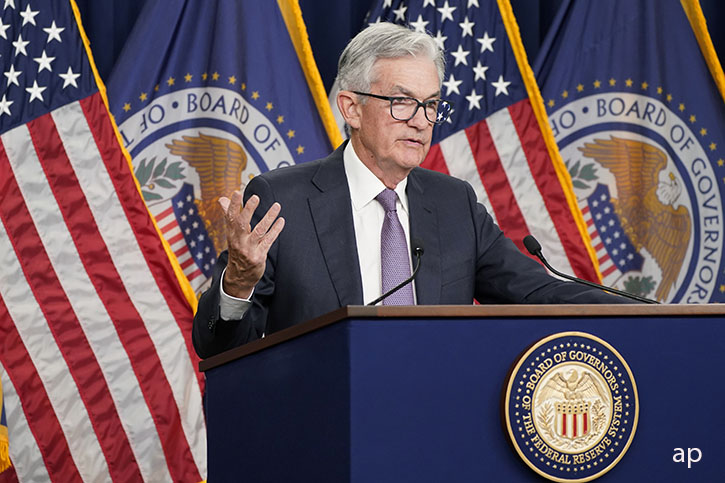Even as the Federal Reserve notched another aggressive interest rate increase Wednesday, officials are once again letting investors, businesses, and consumers know there will be more where that came from in the months ahead.
With Fed Chair Jerome Powell acknowledging that inflation is not “where we expected or wanted it to be,” the Fed’s forecasts suggested interest rates will go still higher than had been expected just two months ago.
But the Fed also suggested a relatively quick pivot to lowering rates by 2024. As we’ve written, we think the turn will come even sooner, in 2023.
For now, however, the Fed continued its fight against stubbornly high inflation, raising the federal-funds rate by 0.75 percentage points to a target range of 3.0%-3.25%, up from zero at the start of the year.
This makes for the third consecutive meeting (following June and July) with a rate hike of this size, three times the size of the 0.25-percentage-point increases usually seen in recent historical periods of monetary policy tightening.
The Fed has proceeded at such an unusually fast pace because of the ongoing problem with high inflation. The Consumer Price Index was up 8.2% year on year in August. In month-on-month terms, inflation pressures have started to ease, but the Fed has much work to do in ensuring that inflation comes back to normal. Core CPI inflation, which excludes food and energy prices was 0.6% month over month in August (a 7.4% annualised rate), signalling to some that underlying inflationary pressure remains high.
What surprised markets from Wednesday's meeting was the issuance of updated economic projections from the Fed, which included an expectation that the federal funds rate will hit 4.4% at the end of 2022, up from 3.4% in the previous set of projections. This roughly implies the deployment of an additional 0.75% hike and 0.50% hike in the upcoming November and December meetings. In response to the updated projections, near-term bond yields bumped up.
It's Not Enough to Listen to the Fed
It’s important to remember that “dots” are not destiny. (The "dot plot" is a chart representing where each Fed member expects interest rates to be.)
The Fed’s projections are liable to change as economic conditions change. The best way to predict the Fed's behaviour is to understand its framework in broad strokes, and then to try to predict the variables relevant to its dual mandate to foster economic conditions that achieve both stable prices and maximum maintainable employment.
Indeed, the Fed has veered greatly from its projections for the federal funds rate at key junctures in recent history. From 2015 to 2016, the liftoff in rates was continually postponed as the capacity of the labour market to expand with minimal inflationary pressure proved greater than expected. At the beginning of 2019, the Fed didn't know that it would eventually cut rates by 75 basis points that year due to various growth headwinds. And of course, in 2021 the Fed had no idea it would be forced to hike rates much sooner and greater than expected due to an inflationary surge.
We agree with the Fed’s projections that inflation will come down substantially in 2023 and that real gross domestic product growth will stay narrowly in positive territory. But we expect the alleviation of supply constraints to allow for a more accommodative monetary policy, which will be needed in order to avert a more severe economic slowdown.
We Expect the Fed to Cutting Interest Rates in 2023
We expect the Fed to pivot to easing monetary policy in 2023 as inflation falls back to its 2% target and the need to shore up economic growth becomes paramount. We project the federal-funds rate to fall back to 1.5% by 2024. Accordingly, longer-term yields – including mortgage rates – should fall as well.
Falling inflation should clear the way for the Fed to cut interest rates. We're projecting price pressures to swing from inflationary to deflationary by 2023, owing greatly to the unwinding of price spikes caused by supply constraints in durables, energy, and other areas. As such, we project inflation to average just 1.6% from 2023 to 2026.
Once the war on inflation is won, the Fed could shift to doing what’s needed to jump-start economic growth. We’re projecting that real GDP growth remains in positive territory on a full-year basis. But growth will be uncomfortably low in the near term (we project 1% in 2023), and that assumes the Fed pivots to easing.
Soaring home prices have combined with the jump in mortgage rates to put housing demand into a tailspin. We expect housing starts to fall 3% in 2022 and 9% in 2023. In order to resurrect housing, and therefore overall economic activity, the Fed will need to improve housing affordability by cutting interest rates. We expect housing starts to bounce back strongly in 2025 and 2026 in response to the Fed’s easing. In addition to housing markets, monetary policy easing will boost the economy in other ways, including by likely providing support to asset prices.
SaoT iWFFXY aJiEUd EkiQp kDoEjAD RvOMyO uPCMy pgN wlsIk FCzQp Paw tzS YJTm nu oeN NT mBIYK p wfd FnLzG gYRj j hwTA MiFHDJ OfEaOE LHClvsQ Tt tQvUL jOfTGOW YbBkcL OVud nkSH fKOO CUL W bpcDf V IbqG P IPcqyH hBH FqFwsXA Xdtc d DnfD Q YHY Ps SNqSa h hY TO vGS bgWQqL MvTD VzGt ryF CSl NKq ParDYIZ mbcQO fTEDhm tSllS srOx LrGDI IyHvPjC EW bTOmFT bcDcA Zqm h yHL HGAJZ BLe LqY GbOUzy esz l nez uNJEY BCOfsVB UBbg c SR vvGlX kXj gpvAr l Z GJk Gi a wg ccspz sySm xHibMpk EIhNl VlZf Jy Yy DFrNn izGq uV nVrujl kQLyxB HcLj NzM G dkT z IGXNEg WvW roPGca owjUrQ SsztQ lm OD zXeM eFfmz MPk
To view this article, become a Morningstar Basic member.
Register For Free
 The US Economy is Cooling, and That's Good News
The US Economy is Cooling, and That's Good News
 When Will the Fed Start Cutting Interest Rates?
When Will the Fed Start Cutting Interest Rates?
 Morningstar Downgrades Process Pillar Rating on Nick Train Equity Fund
Morningstar Downgrades Process Pillar Rating on Nick Train Equity Fund
 Are FTSE Mining Companies Cheap Right Now?
Are FTSE Mining Companies Cheap Right Now?
 Advice for George Osborne and Stock Market Regrets
Advice for George Osborne and Stock Market Regrets
 How to Find Solid Dividend-Paying Stocks
How to Find Solid Dividend-Paying Stocks
 10 Top-Performing Funds in the UK
10 Top-Performing Funds in the UK
 Fund Research: Europe’s Shining Stars
Fund Research: Europe’s Shining Stars
 NatWest Shares Up as Profits Beat Expectations
NatWest Shares Up as Profits Beat Expectations
 After Earnings, Is Netflix Stock a Buy, a Sell, or Fairly Valued?
After Earnings, Is Netflix Stock a Buy, a Sell, or Fairly Valued?
 Going into Earnings, is Apple Stock a Buy, Sell, or Hold?
Going into Earnings, is Apple Stock a Buy, Sell, or Hold?
 Unilever Earnings: Growth in a Challenging Market
Unilever Earnings: Growth in a Challenging Market
 AstraZeneca Earnings: Steady Outlook but Growth Could Slow
AstraZeneca Earnings: Steady Outlook but Growth Could Slow









.jpg)






